
Many advertisers succeed through the use of celebrity endorsements; however, the modern rise of internet celebrity suggests potential for a shift in strategy. Companies wishing to remain relevant should therefore consider influencer marketing campaigns.
Nadine Jarrard CA explains that influencer marketing exploits the parasocial bonds developed between influencers and their fans to employ a more cost-effective endorsement campaign than those involving household names. The most successful campaigns recognize the personalized nature of influencer content and factor this into their marketing approach.
This requires time and patience. However, any marketing team can succeed with enough knowledge of how and why influencer marketing works.
How Influencer Marketing Works
Traditional celebrity endorsements may take the form of posters or televised commercials that air during predetermined time slots. However, influencer marketing embeds the promotion directly into the content. Content creators may devote lengthy segments or even entire videos to the promotion of a single company or product.
Unlike product placement in TV and movies, which serves little purpose other than reminding viewers that a product exists, influencer promotions take a deep dive into the benefits of utilizing a particular product or service. While some could argue that a commercial advertisement achieves the same thing, influencer content provides a number of additional benefits, including:
- Catering to niche communities devoted to specific sub-industries
- Pre-established trust between promoter and audience
- A more authentic alternative to standard advertising copy
- Ability to estimate viewership based on an influencer’s following
- Honest and personalized assessment of a product’s key attributes
- YouTubers and TikTok influencers charge less than big-name stars
Since dishonest promotion might hurt an influencer’s brand, companies wishing to utilize influencer marketing must sometimes resign themselves to giving up a fair bit of control over their marketing image. However, influencer campaigns can still prove widely successful by taking necessary precautions to avoid damaging the company’s own reputation.
Devising an Influencer Marketing Campaign
The first step to organizing a successful campaign is to choose the right influencer. It goes without saying that a company selling cleaning supplies should not bother with a travel vlogger, nor should a travel agency waste time advertising on a video gaming channel. Advertisers should only ally with influencers whose target audience aligns with their own.
Since a key advantage of influencer promotion revolves around the authenticity and personalization of their content, advertisers must communicate with their internet promoters on an equally personal level. This involves:

- Reviewing their content to see how they interact with viewers
- Allowing at least some creative control over the final content
- Avoiding potentially controversial or offensive content creators
- Authenticating viewership with tools like InstaCheck to avoid fake followers
- Allowing for potentially slow growth depending on an influencer’s upload schedule
Above all, advertisers must trust the process. Homemade food product Pink Sauce continued gaining popularity on TikTok amidst allegations of poisoning consumers. Viewers typically trust human faces more than corporate logos. If the right personality can sell them on spoiled pink milk, then a well-designed influencer campaign should be able to sell just about anything.
Conclusion
Influencer marketing cannot succeed through a cookie-cutter approach. Advertisers must understand not only their target audience, but why that audience chooses to trust a particular content creator’s opinion. By tailoring marketing strategies to accommodate these considerations, marketers can carve out their own slice of this nearly $10 billion industry.